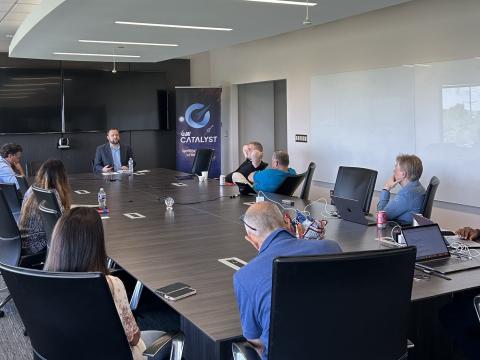After Active Duty: Raising the Bar on Technology
The After Active Duty blog series examines the challenges, rewards and lessons learned for those who have transitioned from active duty to the private sector and the role AFCEA played in this progression.
Shannon Sullivan, a retired Air Force lieutenant colonel, learned lessons as an athlete that served him well throughout his active duty career and beyond.
“Athletics teaches teamwork, discipline and commitment, and those traits translate well to the military and industry,” says the former all-American pole vaulter and first alternate to the 1988 U.S. Olympic decathlon team.
While the phrase “raising the bar” may be an overused cliché for some, for Sullivan, it has become a way of life, especially when it comes to technology.
His career spans 20 years in the Air Force, where he served as a satellite control officer, coached at the Air Force Academy and served as a program manager and commander’s special projects director at the Electronic Systems Center. He commanded a testing detachment, led a $4.2 billion F-16 fighter sale to Poland and served as the senior military advisor to the deputy undersecretary of the Air Force for international affairs.
Now, though, he leads federal business efforts for Google, a company that habitually raised the technology bar. For example, the company offers an entire cloud computing portfolio. “Google is the world's largest Internet service provider, and there is incredible, inexpensive power the government could be using. Just think, we have seven major properties with over 1 billion users—apps, Chrome, YouTube, maps, search, Android and the Play Store. That's huge computing power that can be harnessed for government use,” Shannon says.
He also touts the Chromebook as being “ultra secure” and capable of easily being made “unphishable.” He adds, “With the government moving to a mobile workforce, they need cutting edge security.”
Sullivan also cites the company’s entire collaboration suite “with unlimited storage—body-worn cameras, imagery, anything...unlimited.” He suggests that money currently being spent on storage could be redirected toward more pressing mission issues.
But his cutting-edge ways started long before his current job. As a young major, he helped establish the U.S. Air Force’s first battle laboratory. The battle lab included more than 100 systems in a classified containment area. It was known as “Fort Franklin Battlespace Laboratory” after Lt. Gen. Charles E. Franklin, then-commander of the Electronic Systems Center. “It was all to prove interoperability between Air Force systems before there were any battle labs,” Sullivan recalls. That was in 1996 when interoperability was a relatively new concern following issues arising from the Gulf War in Iraq. The battle laboratory phenomenon swept across the U.S. military. Fort Franklin caught the attention of the Joint Chiefs of Staff. “Bill Owens was the vice chairman of the Joint Chiefs at the time, and he was really pushing for a joint battle lab. He brought the Joint Requirements Oversight Council to Hanscom Air Force Base,” Sullivan reports.
The Fort Franklin lab led to the Air Force’s Expeditionary Force Experiment, which was designed to test command, control, communications, computers, intelligence, surveillance and reconnaissance systems.
Sullivan turned down a promotion and moved to the private sector with a company called BEA, which stood for Bill, Ed and Alfred. “It was a Silicon Valley startup doing service-oriented architecture back when that was still kind of a novel thing,” he says. He worked for Oracle for three years after it bought BEA.
He also has been associated for about 22 years with AFCEA, another organization that is all about raising the bar. AFCEA is a member-based, non-profit association for professionals that provides thought leadership, engagement and networking opportunities in the realm of cyber, command, control, communications, computers and intelligence to address national and international security challenges. “AFCEA programs absolutely steer students toward cutting edge technologies,” he says.
To illustrate the point, Sullivan points out that the Lexington-Concord chapter awards 25 to 30 graduating high school students each year with a paid summer internship in a high-tech company in the Boston area. “Students get to work on the latest projects at companies such as MITRE, Lincoln Labs, Draper Labs and Raytheon,” he says, observing that those students emerge from the program excited about pursuing science, technology, engineering and mathematics (STEM) careers.
Sullivan has held a number of volunteer positions with AFCEA, including regional vice president in the New York area. He now serves as vice chairman of the board. “Obviously, there’s a great network that you develop: industry, academia and the government. So that’s been very valuable, very useful throughout my career,” he offers.
Even more enjoyable, he adds, was the eight years he spent running the Education Foundation of the Lexington-Concord Chapter. “It was a nice blend of helping a variety of young kids find scholarships, find summer employment, all kinds of different events we would sponsor there. It was a great experience,” Sullivan recalls. “I love AFCEA’s commitment to STEM.”
He first became involved with AFCEA on the advice of a mentor, Jim Henderson, who at the time was president of Analytical Systems Engineering Corporation, perhaps better known as ASEC. Henderson told him he needed to belong to AFCEA because the organization would help him develop useful connections and great mentorship opportunities with senior officers. In addition, his own mentor said, AFCEA would provide connections to the business community and help him understand how industry operates, what their motives and objectives are and how he could work better with the private sector.
And it turns out Henderson was right, Sullivan asserts. For instance, when he was at BEA trying to sell a new thing known as service-oriented architecture to government, AFCEA helped open doors. “It’s the same with Google. The Department of Defense is struggling with how to adopt these new technologies, so AFCEA provides a forum—a translation. AFCEA is kind of a translator between Silicon Valley and the government,” he says.
He adds that he would advise other active duty personnel of all ranks to join the organization. “It has done wonders for my career. I would highly encourage them. The sooner, the better,” he says.
He cites the Young AFCEAN program as “just outstanding” and offering “great mentorship opportunities.”
“You can hear some of the leadership both in government and industry. And you’re just doing a lot of rewarding things, all kinds of different STEM activities and involvement in the local community, which I think is very rewarding,” he says.
He also points out that while other forums exist, “very few are nonprofits that are not pushing a particular agenda.” AFCEA is focused instead on “just bringing each other together for good, academic-focused discussions,” Sullivan indicates. “Military members really gain from that and should take the opportunity to use AFCEA and its breadth and understanding of technology, especially nowadays, when the government itself is struggling to keep up with where technology is going,” he asserts.
Join AFCEA now, one of the most cost-effective and efficient ways to help yourself and your career, while having fun and making a difference for many others across the globe.




Comments